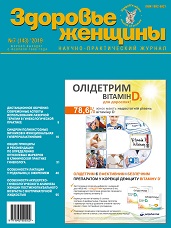Синдром полікістозних яєчників і функціональна гіперпролактинемія
DOI:
https://doi.org/10.15574/HW.2019.143.16Ключові слова:
синдром полікістозних яєчників, функціональна гіперпролактинемія, Vitex agnus-castus, Мастодинон®, Циклодинон®Анотація
У 30–50% жінок з СПКЯ виявляють функціональну гіперпролактинемію. При наданні допомоги жінкам з СПКЯ і функціональною гіперпролактинемією потрібен комплексний підхід, як при діагностиці, так і у лікуванні. Застосування препаратів Мастодинон®, Циклодинон®, що містять точне дозування кількості Vitex agnus-castus, у жінок з СПКЯ і функціональною гіперпролактинемією позитивно впливає на гіпоталамо-гіпофізарно-яєчникову вісь і коригирує основні клінічні симптоми, профілактує виникнення гіперпластичних процесів у статевих органах, підвищує фертильність.
Посилання
Azziz R, Adashi EY. 2016 Feb. Stein and Leventhal: 80 years on. Am J Obstet Gynecol. 214(2):247. https://doi.org/10.1016/j.ajog.2015.12.013; PMid:26704896
International evidence-based guideline for the assessment and management of polycystic ovary syndrome: 196. 2018.
John E. 2008. Nestler Metformin for the Treatment of the Polycystic Ovary Syndrome. N Engl J Med 358:47-54. https://doi.org/10.1056/NEJMct0707092; PMid:18172174
Apter D, Vihko R. 1983. Early menarche, a risk factor for breast cancer, indicates early onset of ovulatory cycles. Journal of Clinical Endocrinology & Metabolism 57(1): 82-6. https://doi.org/10.1210/jcem-57-1-82; PMid:6222061
Van Hooff MH et al. 2004. Predictive value of menstrual cycle pattern, body mass index, hormone levels and polycystic ovaries at age 15 years for oligo-amenorrhoea at age 18 years. Hum Reprod 19(2): 383-92. https://doi.org/10.1093/humrep/deh079; PMid:14747186
International evidence-based guideline for the assessment and management of polycystic ovary syndrome. Human Reproduction 33;9:1602–1618, 2018.
Bozdag G et al. 2016. The prevalence and phenotypic features of polycystic ovary syndrome: a systematic review and meta-analysis. Hum Reprod 31(12): 2841-2855. https://doi.org/10.1093/humrep/dew218; PMid:27664216
Witchel SF et al. 2015. The Diagnosis of Polycystic Ovary Syndrome during Adolescence. Horm Res Paediatr. https://doi.org/10.1159/000375530; PMid:25833060
Vermeulen AL Verdonck, Kaufman J. 1999. A critical evaluation of simple methods for the estimation of free testosterone in serum. Journal of Clinical Endocrinology & Metabolism 84(10): 3666-3672. https://doi.org/10.1210/jcem.84.10.6079; PMid:10523012
Rosner W and Vesper H. 2010. Toward excellence in testosterone testing: A consensus statement. Journal of Clinical Endocrinology & Metabolism 95(10): 4542-4548. https://doi.org/10.1210/jc.2010-1314; PMid:20926540
Taieb J, Mathian B and Millot F et al. 2003. Testosterone measured by 10 immunoassays and by radio-isotopedilution gas chromatography-mass spectrometry in sera from 116 men, women, and children. Clinical Chemistry 49: 1381-1395. https://doi.org/10.1373/49.8.1381; PMid:12881456
Saini S et al. 2016. Gaps in knowledge in diagnosis and management of polycystic ovary syndrome. Fertility and Sterility 106(3): e100. https://doi.org/10.1016/j.fertnstert.2016.07.289
Bili AE et al. 2014. The combination of ovarian volume and outline has better diagnostic accuracy than prostatespecific antigen (PSA) concentrations in women with polycystic ovarian syndrome (PCOS). European Journal of Obstetrics & Gynecology and Reproductive Biology 179: 32-35. https://doi.org/10.1016/j.ejogrb.2014.05.006; PMid:24965976
Freda PU, Beckers AM, Katznelson L, Molitch ME and oth. 2011, Apr. Pituitary incidentaloma: an endocrine society clinical practice guideline. J Clin Endocrinol Metab. 96(4):894-904. doi: 10.1210/jc.2010-1048. https://doi.org/10.1210/jc.2010-1048; PMid:21474686 PMCid:PMC5393422
Lavin N. 1994. Manual of Endocrinology and Metabolism: 224–227.
Escobar-Morreale H et al. 2001. Receiver operating characteristic analysis of the performance of basal serum hormone profiles for the diagnosis of polycystic ovary syndrome in epidemiological studies. European Journal of Endocrinology 145(5): 619-624. https://doi.org/10.1530/eje.0.1450619; PMid:11720881
Deeks A, Gibson-Helm M, Teede H. 2011. Is having polycystic ovary syndrome (PCOS) a predictor of poor psychological function including depression and anxiety. Human Reproduction. Advance access published 2011, March 23. https://doi.org/10.1093/humrep/der071; PMid:21436137
Koskinen P et al. 1996. Optimal use of hormone determinations in the biochemical diagnosis of the polycystic ovary syndrome. Fertility & Sterility 65(3): 517-22. https://doi.org/10.1016/S0015-0282(16)58146-1
Dedov II, Melnichenko GA. 2016. Klinicheskie rekomendatsii: diagnostika i lechebno-profilakticheskie meropriyatiya pri vrozhdennoy disfunktsii koryi nadpochechnikov u patsientov vo vzroslom vozraste.
Zabolotnov VA, Shatilo VI, Rybalka AN, Kupriyanenko AV. 2017. Ot nedostatochnosti lyuteinovoy fazyi k gipotalamo-gipofizarno-yaichnikovoy disfunktsii. Zdorove zhenschiny 8: 35–39.
Zabolotnov VA, Shatilo VI, Ryibalka AN, Kupriyanenko AV. 2018, Traven. Ot nedostatochnosti lyuteinovoy fazy k gipotalamo-gipofizarno-yaichnikovoy disfunktsii. Reproduktivna endokrinologiya 3 (41): 73–76.
##submission.downloads##
Опубліковано
Номер
Розділ
Ліцензія
Авторське право (c) 2019 Здоров’я жінки

Ця робота ліцензується відповідно до Creative Commons Attribution-NonCommercial 4.0 International License.

